Introduction of DMD Method to Study the Dynamic Structures of a Three-Dimensional Centrifugal Compressor with and without Flow Control
Abstract
:1. Introduction
2. Numerical Simulation and Analysis Method of Compressor
2.1. Investigated Centrifugal Compressor
2.2. Unsteady Numerical Calculation Method for the Compressor
2.3. Introduction to DMD
3. Unsteady Flow Characteristics of the Centrifugal Compressor near the Blade Tip
3.1. Quasi-Periodic Variation Flow Field at Blade Tip
3.2. Variation in the Main Coherent Structures
4. DMD for Centrifugal Compressor with and without Flow Control
4.1. DMD Method for Three-Dimensional Flow Field of Compressors
4.2. DMD Spectrum of Controlled and Uncontrolled Compressors
4.3. Dynamic Structures of the Compressor with and without Control
- The influence area of the dominant mode of the controlled compressor is significantly reduced. The controlled vortices no longer distribute in the passage, especially in Passage-I, as if they are in the uncontrolled state (see the red circle in Figure 8). The influence range of the vortices in Passage-II is also small. In the original flow field, the flow in Passage-I is more turbulent than that in Passage-II. The flow in Passage-I exerts a great impact on the compressor performance. Therefore, the improvement of flow in Passage-I can help to improve the compressor performance.
- The structure similar to the leakage vortex can still be seen in Mode-fm under a uncontrolled condition. However, the characteristics of the leakage vortex in the Mode-fmc mode were not obvious after being controlled. This phenomenon is mainly manifested by the periodic “shedding” process of the vortices from the leading edge to the downstream development, but no complete leakage vortices are found (see the green circle in Figure 8).
- For Mode-fm, the flow contains different scales and irregular patterns. However, the irregularity in Mode-fmc decreases, which is mainly manifested by the downstream development of large-scale vortices. Thus, the overall orderliness is high. A comparison of Mode-2fmc that corresponds to the second harmonic generation in the controlled state, and Mode-2fm that corresponds to the second harmonic generation in the uncontrolled state, shows that the order reflected in the second harmonic generation in the controlled state is more obvious. The DMD results show that the effect of unsteady flow control on the structure of small-scale vortices is mainly concentrated in the front half of the passage (from the leading edge of the small blade to the leading edge of the main blade). The influence area of small-scale vortices on the uncontrolled flow field is wide.
5. Conclusions
- (1)
- The coherent structure at the blade tip exhibits a quasi-periodic variation and its dominant frequency is approximately half of the BFP (i.e., 50% BPF).
- (2)
- The DMD spectrum shows that the dominant position of the leakage vortex decreases, the proportion of the high-frequency component increases, and the overall performance of the different vortex structures is uniform.
- (3)
- The dynamic vortex structure obtained by the DMD analysis shows that the leakage vortex is weakened, the influence range of the unsteady fluctuation is reduced, and the overall order of the flow field is improved.
Author Contributions
Acknowledgments
Conflicts of Interest
References
- Pampreen, R.C. Small Turbomachinery Compressor and Fan Aerodynamics. J. Eng. Gas Turbines Power 1973, 95, 251–256. [Google Scholar] [CrossRef]
- Mashimo, T.; Watanabe, I.; Ariga, I. Effects of fluid leakage on performance of a centrifugal compressor. J. Eng. Gas Turbines Power 1979, 101, 337–342. [Google Scholar] [CrossRef]
- Ishida, M.; Ueki, H.; Senoo, Y. Effect of blade tip configuration on tip clearance loss of a centrifugal impeller. Trans. Jpn. Soc. Mech. Eng. 1987, 53, 2099–2103. [Google Scholar] [CrossRef]
- Ibaraki, S.; Matsuo, T.; Kuma, H.; Sumida, K.; Suita, T. Aerodynamics of a transonic centrifugal compressor impeller. J. Turbomach. 2003, 125, 473–480. [Google Scholar] [CrossRef]
- Takahashi, K.; Furukawa, M.; Ibaraki, S. Vortical Flow Structure and Loss Generation Process in a Transonic Centrifugal Compressor Impeller. In Proceedings of the ASME Turbo Expo 2007: Power for Land, Sea, and Air, Montreal, QC, Canada, 14–17 May 2007. [Google Scholar]
- Schleer, M.; Song, S.J.; Abhari, R.S. Clearance effects on the onset of instability in a centrifugal compressor. J. Turbomach. 2006, 130, 993–1003. [Google Scholar]
- Wang, X.; Wang, J.; He, F.; Zhang, H. Effect of Relative Movement between the Shroud and Blade on Tip Leakage Flow Characteristics. Energies 2017, 10, 1600. [Google Scholar] [CrossRef]
- Liu, Y.; Tan, L.; Wang, B. A Review of Tip Clearance in Propeller, Pump and Turbine. Energies 2018, 11, 2202. [Google Scholar] [CrossRef]
- Mailach, R. Rotating Instabilities in an Axial Compressor Originating from the Fluctuating Blade Tip Vortex. ASME Trans. J. Turbomach. 2000, 123, 453–460. [Google Scholar] [CrossRef]
- Yamada, K.; Funazaki, K.; Furukawa, M. The Behavior of Tip Clearance Flow at Near-Stall Condition in a Transonic Axial Compressor Rotor. In Proceedings of the ASME Turbo Expo 2007: Power for Land, Sea, and Air, Montreal, QC, Canada, 14–17 May 2007. [Google Scholar]
- Mao, X.; Liu, B.; Zhao, H. Numerical Investigation for the Impact of Single Groove on the Stall Margin Improvement and the Unsteadiness of Tip Leakage Flow in a Counter-Rotating Axial Flow Compressor. Energies 2017, 10, 1153. [Google Scholar] [Green Version]
- Hah, C.; Voges, M.; Müller, M.W.; Schiffer, H.P. Characteristics of tip clearance flow instability in a transonic compressor. In Proceedings of the ASME Turbo Expo 2010 Power for Land, Sea and Air, Glasgow, UK, 14–18 June 2010. [Google Scholar]
- Hah, C.; Bergner, J.; Schiffer, H.P. Tip Clearance Vortex Oscillation, Vortex Shedding and Rotating Instabilities in an Axial Transonic Compressor Rotor. In Proceedings of the ASME Turbo Expo 2008: Power for Land, Sea, and Air, Berlin, Germany, 9–13 June 2008. [Google Scholar]
- März, J.; Hah, C.; Neise, W. An Experimental and Numerical Investigation into the Mechanisms of Rotating Instability. In Proceedings of the ASME Turbo Expo 2001, New Orleans, LA, USA, 4–7 June 2001. [Google Scholar]
- Lumley, J.L. The structure of inhomogeneous turbulent flows. In Atmospheric Turbulence and Radio Wave Propagation; Nauka: Moscow, Russia, 1967; pp. 166–178. [Google Scholar]
- Chen, J.; Lu, W.; Huang, G.; Zhu, J.; Wang, J. Research on Pulsed Jet Flow Control without External Energy in a Blade Cascade. Energies 2017, 10, 2004. [Google Scholar] [CrossRef]
- Schmid, P.J. Dynamic mode decomposition of numerical and experimental data. J. Fluid Mech. 2010, 656, 5–28. [Google Scholar] [CrossRef] [Green Version]
- Rowley, C.W.; Mezić, I.; Bagheri, S. Spectral analysis of nonlinear flows. J. Fluid Mech. 2009, 641, 115–127. [Google Scholar] [CrossRef]
- Schmid, P.J. Application of the dynamic mode decomposition to experimental data. Exp. Fluids 2011, 50, 1123–1130. [Google Scholar] [CrossRef]
- Seena, A.; Sung, H.J. Dynamic mode decomposition of turbulent cavity flows for self-sustained oscillations. Int. J. Heat Fluid Flow 2011, 32, 1098–1110. [Google Scholar] [CrossRef]
- Nastase, I.; Meslem, A.; Hassan, M.E. Image processing analysis of vortex dynamics of lobed jets from three-dimensional diffusers. Fluid Dyn. Res. 2011, 43, 1073. [Google Scholar] [CrossRef]
- Hong, S.; Huang, G.; Lu, W. Study on a Subsonic Micro-Centrifugal Compressor Stall Mechanism. In Proceedings of the ASME Turbo Expo 2017: Turbomachinery Technical Conference and Exposition, Charlotte, NC, USA, 26–30 June 2017. [Google Scholar]
- Hong, S. Research on Centrifugal Compressor Technology in Microminiature High Efficiency Brayton Cycle. Ph.D. Thesis, Nanjing University of Aeronautics and Astronautics, Nanjing, China, 2018. [Google Scholar]
- Hunt, J.C.R. Eddies Stream, and Convergence Zones in Turbulent Flows; Center for Turbulence Research: Stanford, CA, USA, 1988; pp. 193–208. [Google Scholar]
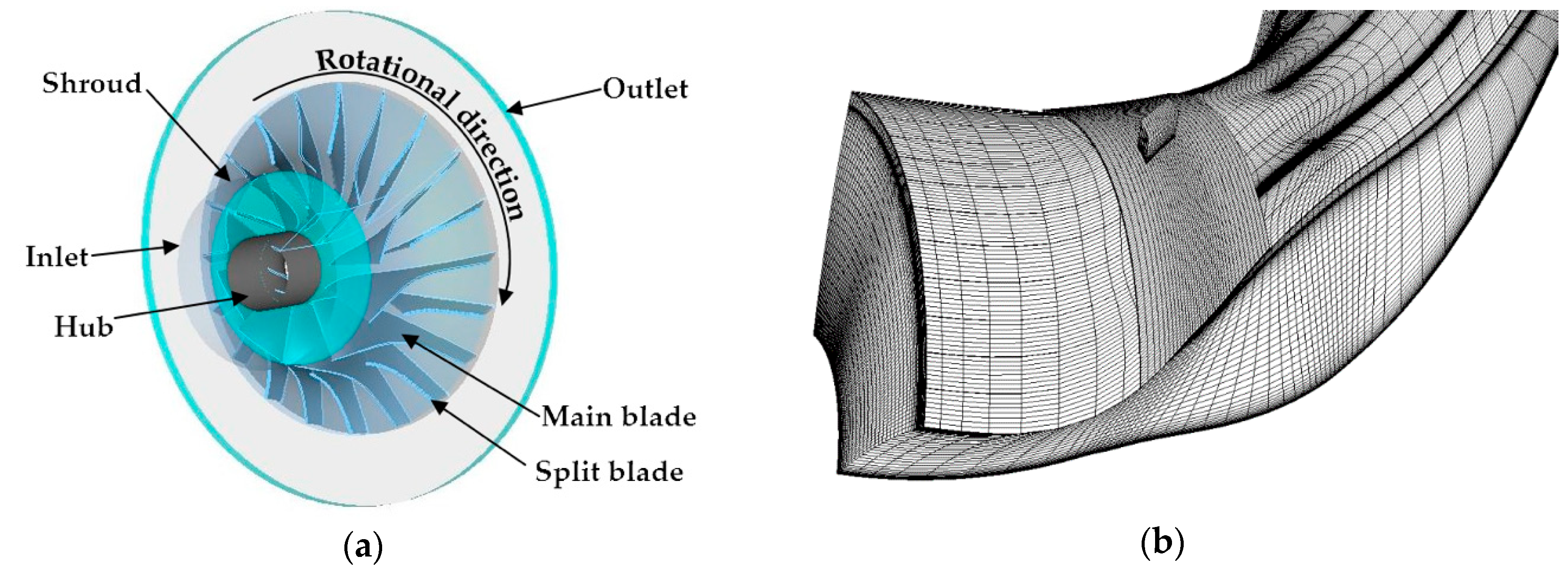
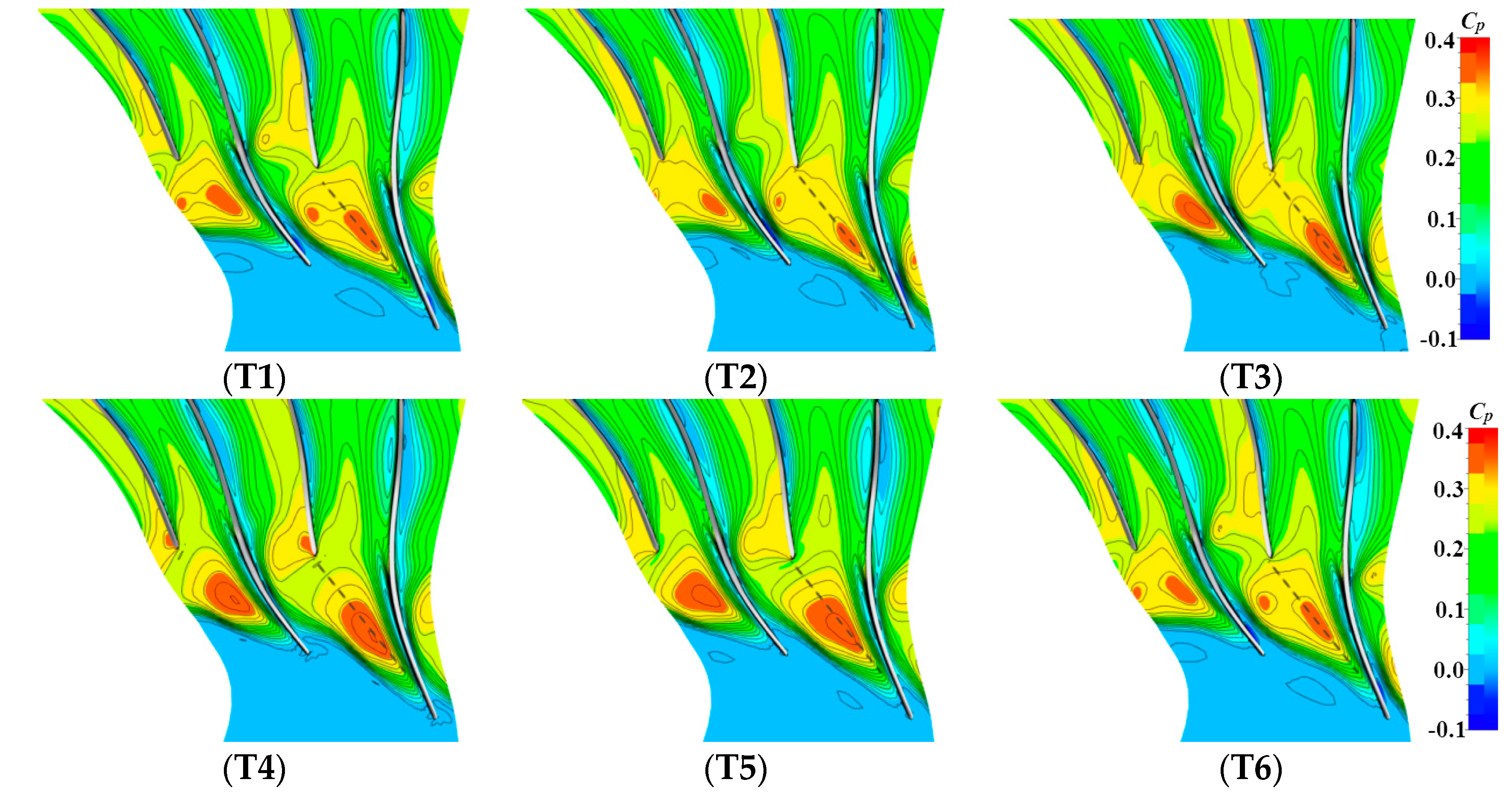
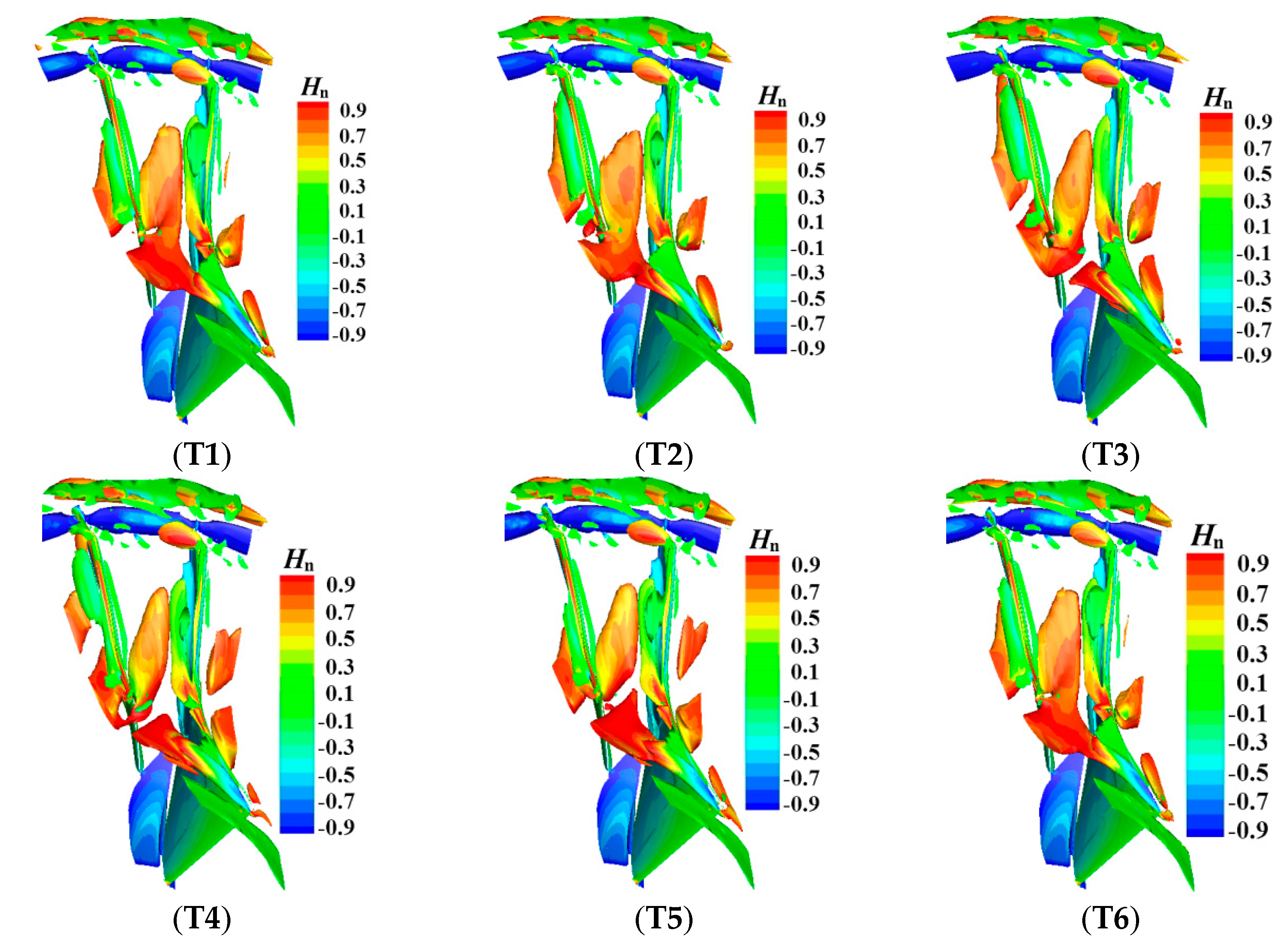
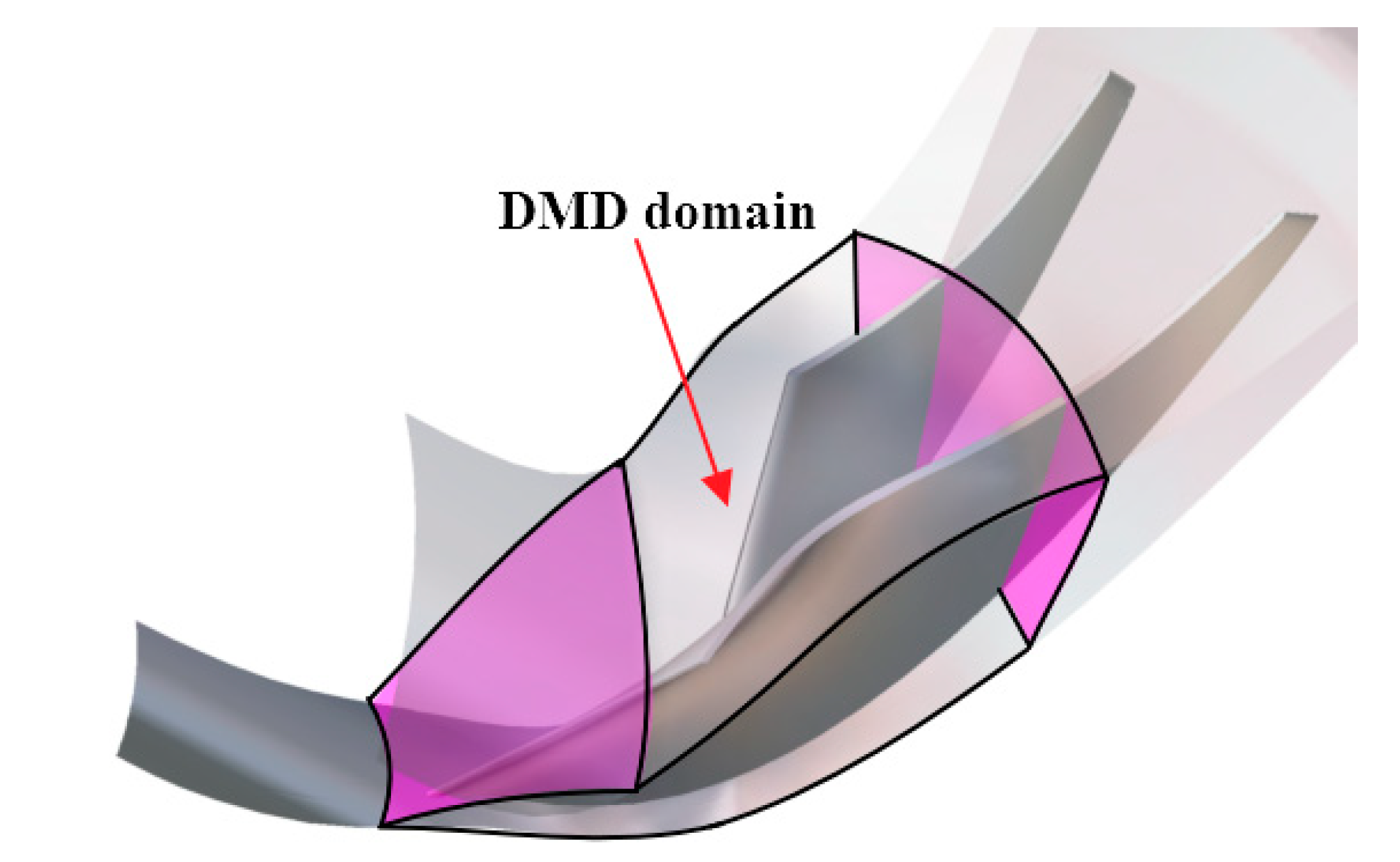
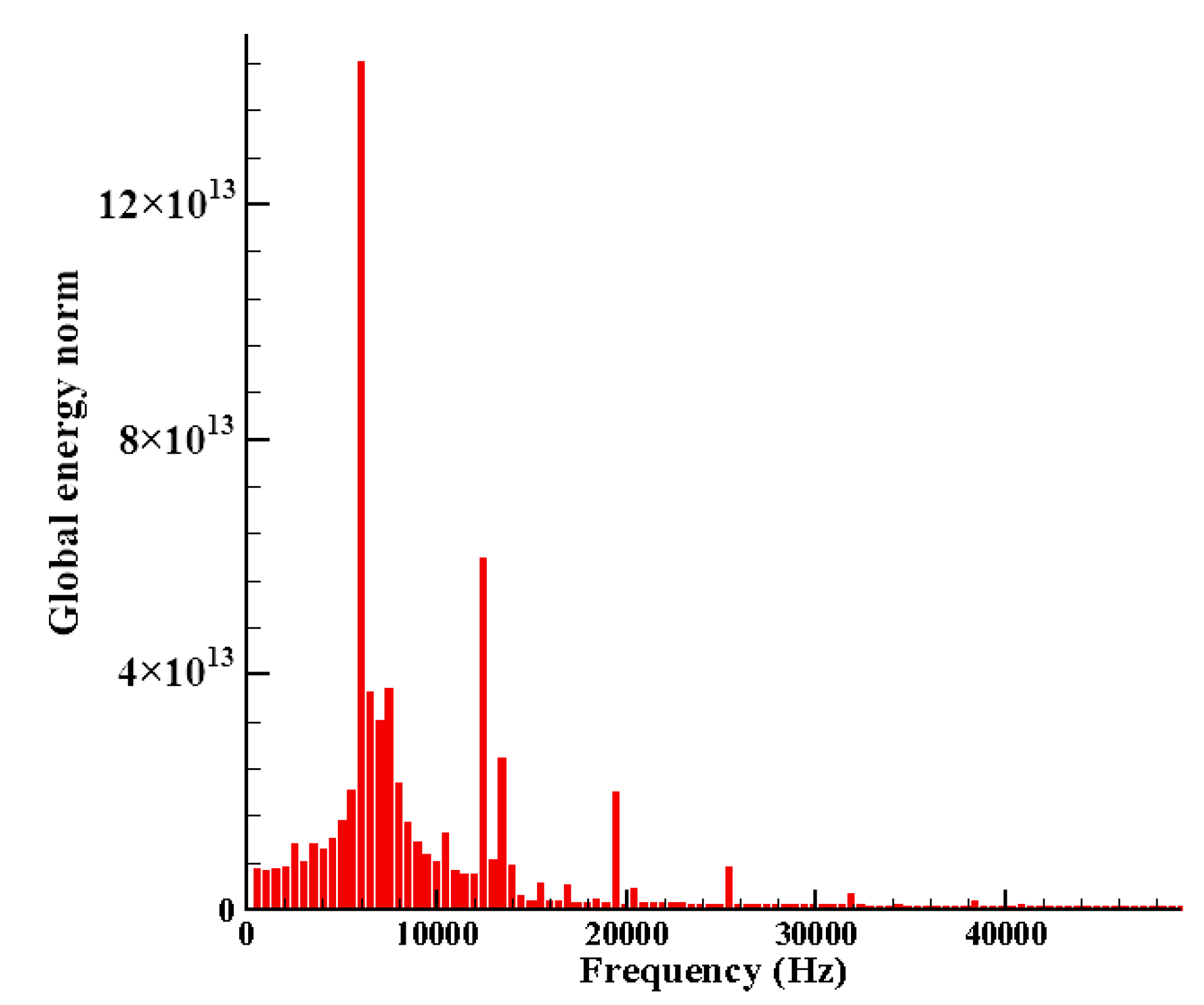
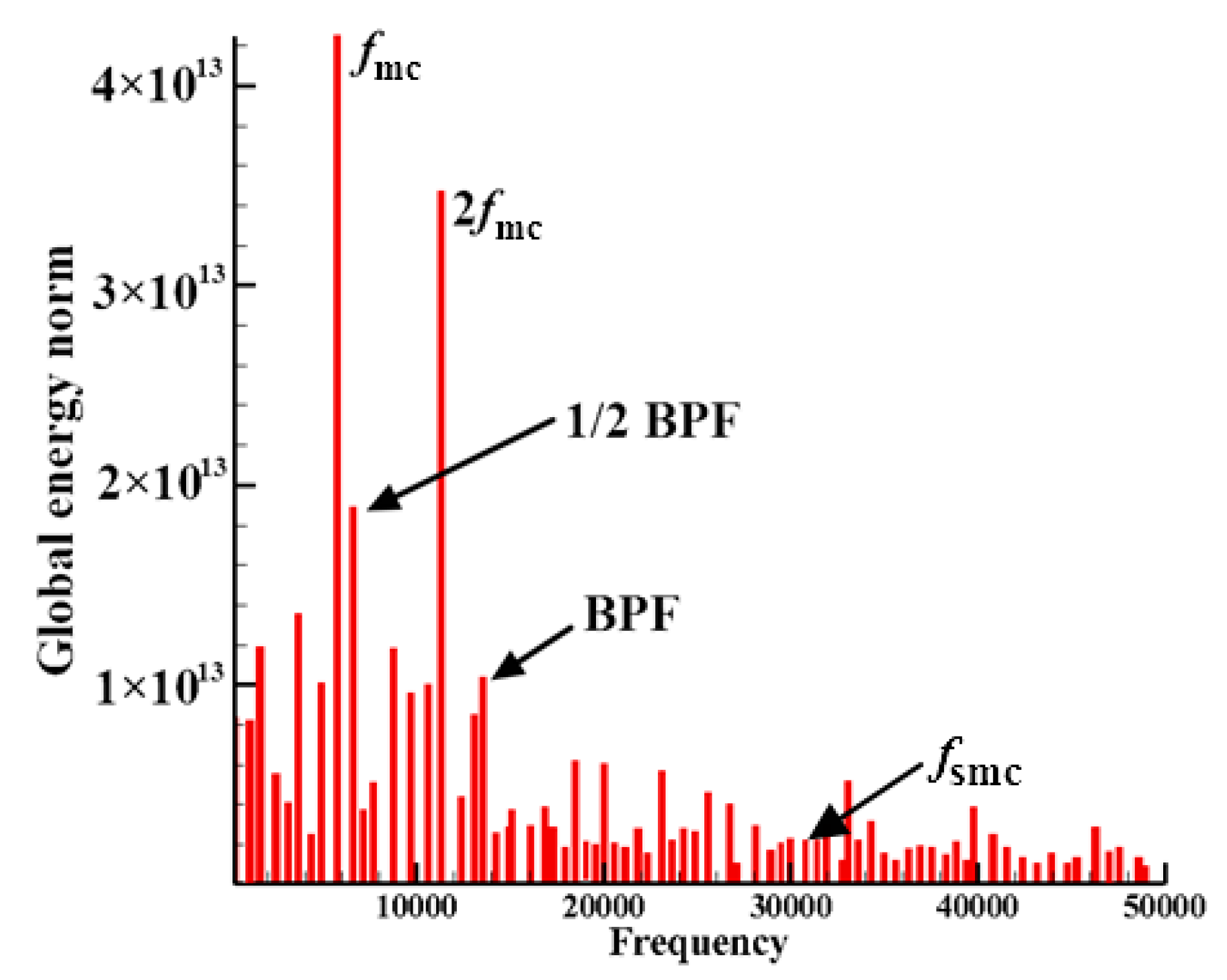

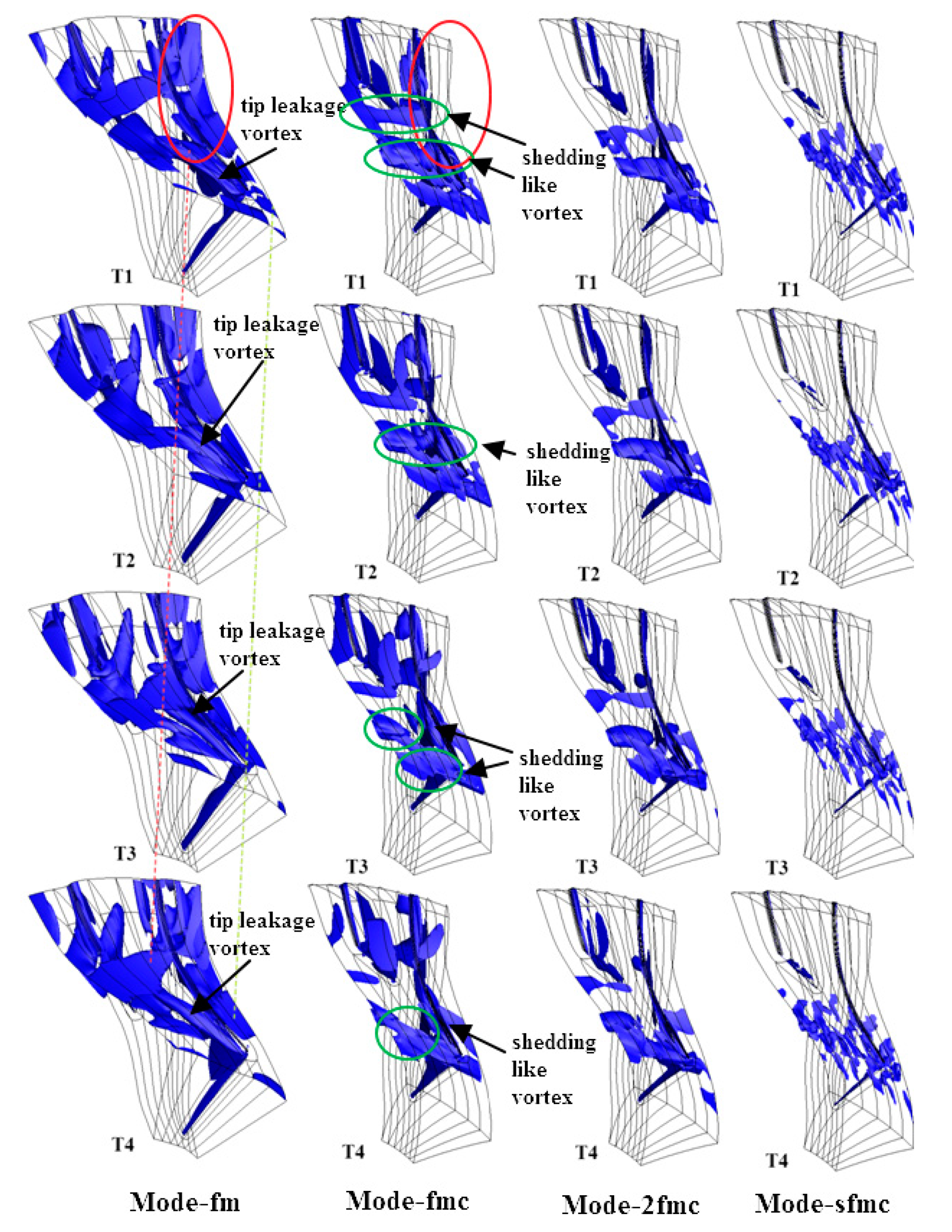
| Performance Parameter | Mass flow (kg/s) | 0.36 |
| Rotational speed (r/min) | 80,000 | |
| Total pressure ratio | 2.9 | |
| Inlet Parameter | Tip diameter (mm) | 59.5 |
| Root diameter (mm) | 19.5 | |
| Relative Mach number at blade tip | 0.87 | |
| Relative airflow angle at blade tip (°) | 30.6 | |
| Relative airflow angle at blade root (°) | 59.3 | |
| Outlet Parameter | Tip diameter (mm) | 98.5 |
| Width (mm) | 4.08 | |
| Absolute airflow angle (°) | 30.0 | |
| Relative airflow angle (°) | 71.7 |
© 2018 by the authors. Licensee MDPI, Basel, Switzerland. This article is an open access article distributed under the terms and conditions of the Creative Commons Attribution (CC BY) license (http://creativecommons.org/licenses/by/4.0/).
Share and Cite
Hong, S.; Huang, G.; Yang, Y.; Liu, Z. Introduction of DMD Method to Study the Dynamic Structures of a Three-Dimensional Centrifugal Compressor with and without Flow Control. Energies 2018, 11, 3098. https://doi.org/10.3390/en11113098
Hong S, Huang G, Yang Y, Liu Z. Introduction of DMD Method to Study the Dynamic Structures of a Three-Dimensional Centrifugal Compressor with and without Flow Control. Energies. 2018; 11(11):3098. https://doi.org/10.3390/en11113098
Chicago/Turabian StyleHong, Shuli, Guoping Huang, Yuxuan Yang, and Zepeng Liu. 2018. "Introduction of DMD Method to Study the Dynamic Structures of a Three-Dimensional Centrifugal Compressor with and without Flow Control" Energies 11, no. 11: 3098. https://doi.org/10.3390/en11113098






